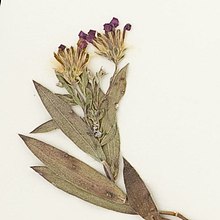Symphyotrichum lucayanum
Appearance
| Symphyotrichum lucayanum | |
|---|---|

| |
| Close-up of inflorescence | |
| Scientific classification | |
| Kingdom: | Plantae |
| Clade: | Tracheophytes |
| Clade: | Angiosperms |
| Clade: | Eudicots |
| Clade: | Asterids |
| Order: | Asterales |
| Family: | Asteraceae |
| Tribe: | Astereae |
| Subtribe: | Symphyotrichinae |
| Genus: | Symphyotrichum |
| Subgenus: | Symphyotrichum subg. Virgulus |
| Species: | S. lucayanum
|
| Binomial name | |
| Symphyotrichum lucayanum | |

| |
| Endemic to Grand Bahama island[3] | |
| Synonyms[2] | |
Symphyotrichum lucayanum (formerly Aster lucayanus) is a species of flowering plant of the aster family (Asteraceae) endemic to the North American island of Grand Bahama.[3]
It has a common name of pineland aster, and it is a perennial, herbaceous plant that may reach 50 centimeters (20 inches) in height. S. lucayanum has purple ray florets.[3]
The holotype for the basionym Aster lucayanus was collected 5 February 1905 at Eight Mile Rock[4] which is roughly at coordinates 26°32′46″N 78°48′31″W / 26.5462°N 78.8087°W.[a] The holotype is stored in the New York Botanical Garden Steere Herbarium, and a high-definition image of it can be found online.[5]

Notes
[edit]- ^ These coordinates are near the present-day Eight Mile Rock police station and high school and were obtained through Google Maps.
Citations
[edit]References
[edit]- Britton, N.L. (1906). "Contributions to the flora of the Bahama Islands III". Bulletin of the New York Botanical Garden. 4. Lancaster, Pennsylvania: Published for the Garden by the New Era Printing Co.: 137–143. Retrieved 31 January 2021 – via Biodiversity Heritage Library.
- Freid, E.H. (2019). "Symphyotrichum lucayanum". IUCN Red List of Threatened Species. 2019. doi:10.2305/IUCN.UK.2019-2.RLTS.T137682802A137682944.en. ISSN 2307-8235. Retrieved 31 January 2021.
- Leon Levy Native Plant Preserve (n.d.). "Symphyotrichum lucayanum". www.levypreserve.org. Nassau: Bahamas National Trust. Retrieved 31 January 2021.
{{cite web}}: CS1 maint: year (link) - POWO (2019). "Symphyotrichum lucayanum (Britton) G.L.Nesom". Plants of the World Online. Royal Botanic Gardens, Kew. Retrieved 31 January 2021.
- Ramirez, J.; Tulig, M.; Watson, K.; Thiers, B. (2021). "Occurrence 5 February 1905 - Aster lucayanus Britt. - Collected in Bahamas - Holotype". The New York Botanical Garden Herbarium (NY). Version 1.30. The New York Botanical Garden. Occurrence dataset (doi.org/10.15468/6e8nje). Retrieved 31 January 2021 – via GBIF.

